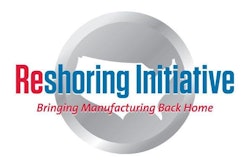
Reshoring is the most direct solution for many of the hottest supply chain issues. Drastically shortened lead time dramatically reduces the complexity of monitoring all levels of a global supply chain and the importance of longer-term forecasting. Shorter distance and lead-time also dramatically improve inventory turns and reduce the risk of supply chain disruption. Increasingly, companies are using Total Cost of Ownership (TCO) or similar sourcing metrics and seeing that these benefits are, in many cases, achievable without sacrificing profitability.
Reshoring Background
Data from the Reshoring Initiative shows that offshoring of U.S. manufacturing is now in balance with reshoring. Since 2003, new offshoring is down by 70 to 80 percent and new reshoring is up by 1,500 percent. The most important accomplishment is that the net-loss of 100,000-plus manufacturing jobs each year has ended. New reshoring is now balancing new offshoring at about 40,000 manufacturing jobs/year, resulting in the first neutral year of offshoring job loss/gain in the last 20—the bleeding has stopped!
As of October 2014, about 170,000 manufacturing jobs have been brought to the U.S. from offshore (400,000 total jobs when including the manufacturing multiplier effect of approximately 1.4). That job gain is the result of both new reshoring—the return of manufacturing work that was previously produced offshore—and FDI (Foreign Direct Investment) in the manufacturing sector. These trends represent about 25 percent of the total increase in U.S. manufacturing jobs since the low in February 2010[1]. For the economy, the continued challenge is to bring back another 3-4 million manufacturing jobs that are still offshore. Meeting this challenge requires that the positive trends that are already bringing work back, such as rising costs offshore and lower energy costs at home, continue. Additionally, the U.S. can improve its competitiveness, in the following manner:
First, in the short to medium term, use of TCO (Total Cost of Ownership) or similar comprehensive metrics—getting companies to recognize all of the benefits of local production and adopt a more comprehensive total cost analysis—is the most effective action to accelerate the return of manufacturing and balance the trade deficit. Increased use of TCO, alone, could cut the trade deficit by 25 percent and bring back one million manufacturing jobs. This requires educating companies to use TCO, and is entirely under the control of our society and corporate culture. Detailed, objective reporting on reshoring successes is a necessary element to motivate companies to reevaluate offshoring.
Second, in the longer term, to get the other 75 percent requires improved competitiveness with political and societal actions: tax reform, currency/tariffs, skilled workforce expansion, etc. All involve politics, most are cultural and endemic. Currency/tariffs are subject to WTO rules, and are influenced by other countries’ actions. There must be much more progress on these fronts in decades to come than there has been in the past.
Ideally, it is best to do both sets of actions. We should be enthusiastic about reshoring as an important element of the manufacturing renaissance but not optimistic about the renaissance until all companies are using TCO for their sourcing decisions and the longer-term actions are being implemented.
Implications for Supply Chains
Here is a list of important supply chain and related issues and how each is mitigated by local sourcing, especially in a developed country. These advantages should be enough to motivate companies to reevaluate offshoring to see whether the overhead, risk and strategic benefits of reshoring now offset the, typically higher, domestic cost of goods sold.
As manufacturing returns from offshore, regional/industrial clusters will continue to evolve, requiring ongoing adaptation of supply chains. Knowing how reshoring/FDI and supply chains mutually influence one another can help supply chain professionals set up infrastructure in anticipation of and in support of a continued trend toward localized manufacturing.
By reshoring, companies can more easily respond to customers’ changing needs, minimize supply chain disruptions and eliminate the larger production runs and inventories associated with long distance offshoring. Shorter supply chains provide the agility needed for mass customization. Localization shortens supply chains and positions manufacturing near engineering and customers, which gives companies better flexibility to respond and customize quickly.
Reshoring can be an important part of a lean strategy. W. Edwards Deming wrote
“End the practice of awarding business on the basis of price tag. Instead, minimize total cost.”[2] The impact of offshoring on each of the Seven Toyota Wastes is described in the table below.
When manufacturing is moved next to engineering, companies can improve design, eliminate waste, improve quality and increase productivity, often making a better product more easily and at a lower cost. When productivity is increased, it makes the product easier to reshore by reducing the U.S. manufacturing and total cost vs. offshore. In many cases companies find that, although the production cost is lower offshore, the total cost is higher, making it a good economic decision to reshore manufacturing to the U.S.
In order to help companies objectively decide where to manufacture, the not-for-profit Reshoring Initiative offers a free Total Cost of Ownership Estimator™ to calculate the real P&L impact of reshoring vs. offshoring. In 2013 the Department of Commerce created the ACE Tool (Access Costs Everywhere) to promote reshoring and greater use of TCO analysis. The most recent addition to ACE is the cost differential frontier (CDF) tool, which allows companies to quantify the potential savings derived from reducing lead-time.
Trending Now
Currently, the top industries reshoring, by number of jobs, have been transportation equipment, electrical equipment, computer products, fabricated metal products and wood products.
The most commonly cited reasons for reshoring are lead-time, quality, automation/productivity, rising offshore wages, currency variation, skilled workforce and government incentives.
Sixty percent of reshoring is coming from China, where wages have been rising at more than 15 percent a year. The Midwest and Southeast are the strongest regions for reshoring, with South Carolina and Michigan leading the pack.
Other factors are helping, too. Walmart’s commitment to source an additional $250 billion in U.S. products through 2022 is having a large impact. We estimate this program could add 300,000 U.S. manufacturing jobs. The U.S. shale gas and oil boom is also playing a key role. The American Chemistry Council has identified more than $136 billion in announced capital expenditures driven by the boom. Much of this investment will be made in equipment manufactured in the United States.
Reshoring is not just a U.S. phenomenon. The economic benefit of producing near the consumer is universal, applying to all countries. The reshoring trend has begun and seen a recent up-tick in Western Europe, and other regions that saw manufacturing go offshore in the past.
Replacing imports should become more of a focus than expanding exports. The U.S. trade deficit in goods equals about 25 percent of our manufacturing output—we can balance the trade deficit by substituting domestic production for imports. In doing so, we will increase U.S. manufacturing employment by 3 to 4 million jobs and overall U.S. employment by 6 to 9 million jobs due to the manufacturing multiplier effect.
Reducing imports, is more cost effective than increasing exports because U.S. factories are about 30 percent more price competitive here than when exporting, for example, to China.
[1] There were 11.45 million manufacturing jobs in February 2010. About 12.2 million Americans are now employed in the manufacturing sector.
[2] “4th Key Principle for Management,” Out of the Crisis, W. Edwards Deming








